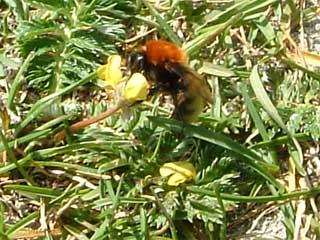Linkages between Functional Traits can Predict Ecosystem Services
Published on 3 April 2014 in Sustainability and Communities , Ecosystems and biodiversity

Introduction
Plant functional traits (characteristics that define species in terms of their ecological roles and interactions) have been shown as effective indicators of ecosystem function and hence the delivery of ecosystem services. For instance, there are strong correlations between management intensity and traits related to leaf investment and leaf longevity, which in turn control key services such as plant growth (primary production) and nutrient cycling.
However, certain services, such as pollination and pest control, are delivered by trophic levels other than the primary producers (plants). Organisms that deliver services from these other trophic levels may not be directly affected by land management that acts on the plants present. What is needed is a mechanistic way to identify how the impacts of land management cascade through the entire ecosystem. A framework has been proposed that does this through linking functional traits between trophic levels. For example, pollinator communities are controlled by the availability of floral resources and the structure of flowers – short-tongued bumblebees cannot feed on flowers with deep set nectaries. Hence, in this example, what needs to be understood is how management affects the flower traits in the vegetation, and how these in turn affect the pollination.
Research at the James Hutton Institute has addressed how traits can be used to link different trophic levels and to understand how management impacts cascade through functional pathways in ecosystems. This was done via a simultaneous study of plant, bee and carabid beetle communities.
Key Points
- Plant functional traits were very successful at explaining the distribution of ground beetle [Coleoptera: Carabidae] functional traits across the habitats studied. Key carabid response traits appeared to be body length and wing type.
- Plant traits proved to be a moderately effective predictor of bee assemblage structure. However, the use of plant traits did not offer any improvement on models directly developed from management variables, suggesting that potentially better traits, such as nectar production rates and pollen protein content, need to be quantified for large numbers of plant species.
Research Undertaken
A large-scale study simultaneously surveyed plant, bee and carabid beetle communities across a wide range of land use intensities within a small area of west coast Scotland (to minimise variation caused by climate and geology). These data were supplemented by data on management, soils and a number of ecosystem processes.
A range of multivariate methods including variance partitioning and RLQ analysis were used to analyse the relationship between traits of the plants and the carabid beetles. The power of plant functional traits to explain the pattern of carabid functional traits was high; adding additional information on soils or management explained very little extra variance. Leaf dry matter content (a measure of the balance of investment in leaf tissue between metabolically active tissue and structural tissue), growth form, height and leaf size were all plant traits that strongly influenced the functional structure of the carabid community. The traits that linked the carabid community to the plants included size, wing type and diet. This strong linkage between plant functional traits and the functional traits of the beetle assemblage was not expected as only a small proportion of the beetle fauna was classified as phytophagous. It is likely that the main influence of plants is via structuring of the habitat of these mainly predatory carabids.
Bee foraging numbers were only weakly predicted by plant traits. However, the structure of the bee community was closely related to a number of different groups of plant traits, including flower colour, forage index (a relative measure of preference from other studies) and plant family. In turn, these traits were significantly correlated to some of the response traits that linked the plant community to management. This indicates that there was a predictive pathway from management to bee abundance and assemblage structure. However, models developed with just the environmental drivers proved superior at predicting both bee numbers and assemblage, suggesting that there is still research and data gathering needed, in order to develop new plant functional traits that will better link with the pollinator community.
Together the studies suggest that traits can be used as proxies to measure trophic linkages that can be used to analyse and predict the impact of environmental change on multiple trophic levels and the ecosystem functions and services that they control.
Policy Implications
A trait-based understanding of community dynamics provides a potentially robust method to examine the consequences of policy decisions on ecosystem services.
The trait-based framework offers the potential to construct a means of integrating fragmented knowledge in complex systems to predict how the impact of environmental drivers can propagate through multiple levels in a complex system, and to examine how these drivers ultimately impact on ecosystem processes and services.
The framework can also be used to analyse trade-offs or synergies between ecosystem services, using the functional composition of the plant community to integrate the impacts of drivers.
Current knowledge on traits for groups other than higher plants remains a constraint for understanding how environmental change can affect ecosystem services. Key response and effect traits need to be identified for taxa that play key roles, such as pollinators or in controlling pest numbers.
Authors
Professor Robin Pakeman, James Hutton Institute robin.pakeman@hutton.ac.uk
Dr Jenni Stockan, James Hutton Institute jenni.stockan@hutton.ac.uk
Topics
Sustainability and Communities , Ecosystems and biodiversity





